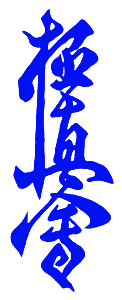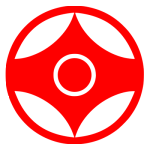Karate Kyokushinkai
Karate Kyokushinkai is a style of Japanese martial arts, founded by Masutatsu Oyama; it is one of the most complex martial arts in the world, which places emphasis both on a balanced physical development and on a mental and disciplinary growth. It is a full-contact style of fight, extremely efficient in self-defense, appropriate for children, women, elderly people and athletes alike.
The Karate Kyokushin classes have in view the improvement of one’s physical fitness, the development of a balanced, healthy body, the growth of strong mind and spirit, of self-confidence, the improvement of courage and self-assurance self-respect and respect for the others, increased attention span.
Kyokushinkai Anthem
Kyokushinkai Kanji

In Japanese calligraphy, kanji, present on the gi (training suit) chest, includes three characters:
- KYOKU – it means ultimate, fundamental
- SHIN – it means truth, reality
- KAI – it means organization, association
The literary translation is “The School of Supreme Truth”.
Kyokushin Karate Symbol

The Kyokushin Karate symbol is Kanku. Kata KANKU (originally, a single one, then taught in many schools under two forms KANKU DAI and KANKU SHO) begins by lifting the arms, with a circular movement, above the head, where they stop. The thumbs and forefingers are joined together and represent the KANKU symbol (slightly conventional form). Throughout the execution of this movement, the eyes look through the opening shaped by the joining of the hands, far away toward the sky. In fact, this is a look into the inner human being, in view of favoring the spiritual and body union. The points of the KANKU symbol are the fingers and they represent the limits or the extremities; philosophically, they denote the finite, limited element. The wide lateral segments are the hand, SHUTO or the fist as expression of the face or of the power. The center of the KANKU symbol is the space between the hands and it suggests the infinite, the unfathomable, the philosophical void. The circles, both the inner and the outer one, suggest continuity and the permanent circular motion.
“Kanku symbolizes the arm strength and the harmony by which you can see the infinite. The circle symbolizes continuity, including countless points, each of which symbolizes the moment.”
Karate Kyokushin Grades (Ranks)
The Karate Kyokushin grades are divided in kyu grades for apprentices (jap. kohai) and in dan for instructor (jap. senpai) and trainers (jap. sensei). The kyu grades beging from 10 and go downward to kyu 1, grades accompanied by color belts, for the differentiation of the ranks. The colors of the belts are different each two grades, having specific colors of orange (kyu 10 and 9), blue (kyu 8 and 7), yellow (kyu 6 and 5), green (kyu 4 and 3) and brown (kyu 2 and 1). For the instructors and trainers the belts are black, and the grading increases from 1 to 9. The maximum value of the dan ranks, 10 dan, is reserved to the style founder, called sosay.
Belt Color Meanings
| White | No Kyu | The level of purity and hidden potential, the beginner knows nothing about karate, he/she has no experience. | |
| Orange | 10&9 Kyu | The level of stability, it symbolizes the glimmer of early dawn in the night sky. | |
| Blue | 8 & 7 Kyu | The level of volatility, the capacity to adapt, it symbolizes the color of the sky before sunrise. | |
| Yellow | 6 & 5 Kyu | The level of approval, it denotes – the sun rises on the sky. | |
| Green | 4 & 3 Kyu | The emotional level, the level of sensitivity, owing to the sun, nature turns green. | |
| Brown | 2 & 1 Kyu | The creative level, the color of the tree, of the earth – it symbolizes maturity. | |
| Black | 1-9 Dan | The level of excellence, black absorbs everything, so that traditionally it is deemed a symbol of wisdom. |
Description of the technique
The introduction to Kyokushin means familiarization with three main elements: technique, discipline/form, sparring. They are called sometimes the three “K’s”, according to their Japanese equivalents: kihon (technique), kata (form) and kumite (sparring).
Kihon is a combination of techniques performed in motion or on place, based on a logic and practical idea of their execution. Performed in compliance with the essential principles, they are the basis of the technique accomplishment and of the development of excellence and skills for the execution of kata and the approach of kumite.
Kata is an imaginary fight with more opponents, which focuses on the development of speed, the strengthening of muscles, the increase of expansion, the improvement of respiration and the impression of blockages in the unconsciousness; it is a sequence of blockages and arm and leg attacks, executed in one or more positions, involving a certain number of motions ahead, back and laterally.
Kumite is the karate branch that involves direct fight between two partners. According to the current regulation of the I.K.O. Sosai, it involves sudden arm and leg hits in full-contact system.
Karate Kyokushin classes in Sibiu – taking place at TERRASPORTIKA Sports Club – sensei Ovidiu Bastea
We run sports training for children (girls and boys), adults, beginner or advanced levels.
